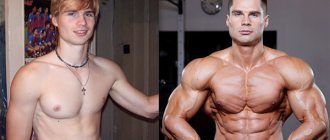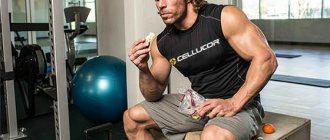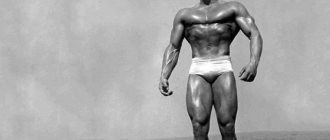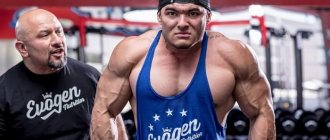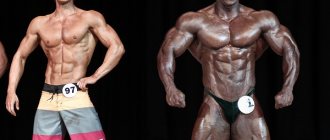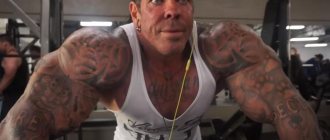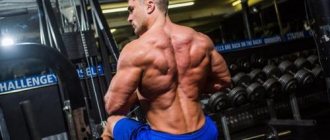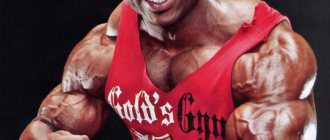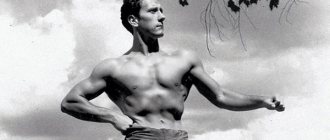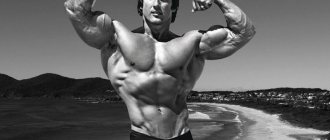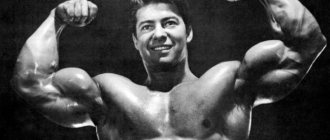Джефф Сейд антропометрия: Рост – 183 см, Соревновательный вес – 93 кг, Бицепс – 46 см, Объем груди – 130 см, Талия – 76 см,
Первое место на «IFBB Stockholm Pro» – 1 раз.
Страницы биографии Сейда
Джефф Сейд (Jeffrey Seid) появился на свет 12.06.1994 в городе Рентон, штат Вашингтон. В 5 лет начал интересоваться спортом. Папа отдал мальчика в секцию легкой атлетики и на футбол. К подростковому возрасту тот успел ознакомиться с биографиями чемпионов тяжелой атлетики и их тренировками. Желание нравиться девочкам подтолкнуло взять в руки снаряды. В подарок от родителей на 12-летие получил комплект спортивного оборудования.
Невинное хобби скоро переросло в серьезное увлечение и отнимало все свободное время. Однако Джефф упорно мечтал о карьере футболиста. Им двигало честолюбие и желание «оставить после себя долгую память». Парень активно тренировался и выступал в сборной городской команде по футболу. За это получал стипендию, позволявшую оплачивать учебу в колледже. Все складывалось отлично, пока на последнем курсе обучения Джефф не порвал крестообразную связку. После реабилитации через 2 месяца история повторилась. Это вынудило окончательно сменить вид спортивной деятельности.
Среда: Ноги/Икры/Кардио
Не суперсет:
- Приседания: 5 подходов по 15, 10, 8, 6, 4
Суперсет:
- Фронтальные приседания: 4 подхода по 12, 10, 8, drop set 8, 6
- Гакк машина: 4 подхода по 12, 10, 8, drop set 8, 6
Не суперсет:
- Жим ногами: 4подхода по 10, 8, 8, 6
Суперсет:
- Разгибания: 4 подхода по 12, 10, 8, 8
- Сгибания: 4 подхода по 12, 10, 8, 8
Не суперсет:
- Подъемы на икры стоя: 4 по 15
- Наклонные подъемы на икры: 4 по 15
- Подъем на икры сидя: 4 по 15
Успехи красавчика в Men’s Physique
По воле рока стал участвовать в соревнованиях по пляжному бодибилдингу. Еще до первой операции на сайте bodybuilding.com парень обратил внимание на новую категорию «Менс физик». Вот тут и пригодился 6-летний опыт таскания железа. На премьерном выступлении занял призовое место. Спустя год получил статус профессионала и стал самым молодым членом федерации IFBB. 2012-13 гг. стали ключевыми в спортивной карьере. Джефф Сейд часто выступал на соревнованиях и не занимал ниже 2-го места. В 2014 он опустился ниже на одну ступеньку. Однако выступление на Олимпии было неудачным, выше 11 позиции подняться не получилось.
Сейд взял паузу и начал сниматься для обложек Iron Man и Men’s Fitness. Написал книгу с пошаговым руководством для бодибилдеров, занимался бизнесом. В 2016-м с новым силами выступил в «Stockholm Pro» и победил, обойдя Антона Антипова и Дениса Гусева. Джефф Сейд в 2017-18 продолжает усиленно тренироваться и готовится покорить Олимпию.
| Год | Соревнования | Место |
| 2012 | NPC Vancouver & Tanji Johnson Classic Men’s Physique | абсолютный чемпион |
| 2012 | NPC Emerald Cup Men’s Physique | 2 |
| 2012 | Чемпионат южных штатов | абсолютный чемпион |
| 2012 | Чемпионат штата Вашингтон | абсолютный чемпион |
| 2012 | NPC чемпионат США | 5 место в классе D |
| 2012 | IFBB чемпионат Северной Америки | 2 место в классе В |
| 2013 | Jr. Nationals | абсолютный чемпион |
| 2013 | IFBB Pro Wings of Strength | 1 |
| 2013 | IFBB Tampa Pro | 2 |
| 2013 | IFBB Europa Supershow | 6 |
| 2013 | IFBB Pro Venti Gold Cup | 1 |
| 2013 | IFBB Olympia Men’s Physique | 11 |
| 2014 | IFBB Europa Show of Champions | 5 |
| 2014 | IFBB Prestige Crystal Cup | 4 |
| 2014 | IFBB Greater Gulf States Pro | 2 |
| 2014 | IFBB Tampa Pro | 11 |
| 2014 | IFBB Dallas Pro | 3 |
| 2014 | IFBB Olympia Men’s Physique | 13 |
История выступлений Джеффа Сеида
| Турнир | Категория | Дата проведения | Страна и город | Место |
| Мистер Олимпия 2016 | Менс Физик (Men’s Physique) | 2016 | Лас-Вегас, США | 16 |
| Мистер Олимпия 2014 | Менс Физик (Men’s Physique) | 2014 | Лас-Вегас, США |
«Без правильного питания я пришел бы в никуда»
Исходя из собственного неудачного опыта, Джефф рекомендует составлять меню в зависимости от конституции тела и экспериментировать с вариантами диет. Хотя в его рационе присутствует много спортпита, основная миссия в построении крепких мышц отводится питанию.
«Моя любимая добавка — гейнер. Я не могу постоянно есть, чтобы набрать положенные 5000 ккал, поэтому выбираю спортпит с минимумом сахара. Смотрю, чтобы в составе были сложные углеводы, белки, способствующие набору массы, а не веса».
Джефф не принимает предтренировочные комплексы и советует вместо них «тратить деньги на хорошую еду». Допинг рекомендует принимать в случае острой нехватки энергии.
Меню спортсмена:
- Запаренная овсянка с бананом + белки + Animal Pak, Chromium Picolinate.
- Гейнер + молоко + ложка льняного масла.
- Птица или рыба + коричневый рис.
- Перед работой: Nutrex Hemorage Black.
- Во время — Optimum Nutrition BCAA.
- После — порция гейнер + банан + креатин + витамин С.
- Белковое блюдо с гарниром из сложных углеводов.
- Казеиновый протеин + ZMA перед сном.
Лучшие упражнения для мышц пресса и косых мышц живота !
0
Вам также может быть интересно«Men’s Physique» 0
Жако де Брюйна (Jaco De Bruyn) WBFF PRO Жако де Брюйна (Jaco De Bruyn) WBFF PRO Профессиональный спортсмен фитнес модель Жако де «Men’s Physique» 0
Херардо Габриель (Gerardo Gabriel) IFBB PRO Херардо Габриель (Gerardo Gabriel) IFBB PRO Профессиональный спортсмен фитнес модель участник соревнований Arnold classic Самое популярное
гриф, Программы тренировок хедер>хедер>
Сколько весит гриф штанги?
Программы тренировок
Программа тренировок Арнольда Шварценеггера
“Бикини”
Екатерина Усманова
Программы тренировок
Программа домашних тренировок для подростков 11-17 лет
Джефф Сейд и его хардкордная программа тренировок
«Я постоянно ее меняю, чтобы заставить мышцы расти. Качок интуитивно чувствует, когда мышцы привыкают, и кардинально меняет схему. Только пресс качаю 15 минут без остановки, выбирая упражнения по настроению».
Недельный план построен на локальных тренировках и суперсетах.
В понедельник в фокусе внимания лодыжки и торс. В плане:
- разведения гантелей в стороны и жимы на скамье средним хватом с приподнятой спинкой;
- «Бабочка» и жим лежа на горизонтальной поверхности;
- жимы вниз головой + отжимания на брусьях;
- «ослиные» подъемы;
- работа на пресс.
Во вторник под прицелом ноги. Джефф использует:
- фронтальные приседания и классические приседания со штангой;
- гакк-приседы и сгибания валиков лежа в тренажере;
- жимы платформы.
Среду посвящает проработке рук с разных ракурсов. В комплексе:
- подъемы на бицепс и на трехглавые пучки сидя и лежа;
- работа в тренажере Скотта + классический французский жим со штангой + изолированные сгибания на двуглавые пучки;
- проработка брюшных мышц.
В четверг по графику спина. В программе:
- становая тяга;
- тяги в наклоне к подбородку и подтягивания за голову;
- горизонтальные тяги блока к груди широким хватом + подтягивания;
- Тяга Т-образного грифа и тяга верхнего блока
- пресс.
В пятницу качает трисетами дельты с помощью:
- махов гантелей перед собой и в стороны из прямого положения и в наклоне;
- тяг к подбородку;
- шраги со штангой.
Шестой день – повтор программы первого дня В воскресенье восстанавливается, затем повторяет программу по кругу.
Понедельник: Грудь/Икры/HIIT
Суперсет:
- Жим штанги в наклоне: 4 подхода по 10, 8, 8, drop set 6, до отказа
- Разводы гантелей на наклонной скамье: 4 подхода по 10, 10, 8, 8
Не суперсет:
- Кроссовер в блоке: 4 подхода по 15, 10, 8, drop set 8, до отказа
Суперсет:
- Жим гантелей лежа: 4 подхода по10, 8, 8, 6
- Брусья: 4 до отказа
Суперсет:
- Жим в наклоне (на тренажере): 3 подхода по 10
- Отжимания: 3 подхода до отказа
Не суперсет:
- Пулловер: 3 по 15
- Подъемы на икры стоя: 4 по 15
- Наклонные подъемы на икры: 4 по 15
- Подъем на икры сидя: 4 по 15
Источники витаминов
Фрукты
в первую очередь. Особенно содержащие витамин С цитрусовые, киви, яблоки, клюква. Абрикосы полезны богатым содержанием калия и магния, гранаты содержат большое количество железа.
Свежие овощи
— помидоры, морковь, шпинат — богаты антиоксидантами, каротинами, а помидоры — кладезь ликопина.
Лук, чеснок и зелень
— богатейший источник целого ряда необходимых микроэлементов, витаминов, антиоксидантов, фитонцидов и других веществ. Они помогают переживать стресс (а каждая тяжелая тренировка — стресс для организма), повышают сопротивляемость и выносливость организма, укрепляют иммунитет и оказывают ряд других полезных действий на организм спортсмена.
Была ли полезна эта статья? Да Нет
Ask a baseball fan to name a lineup of the all-time greats at each position, and he might sprain a lobe trying to choose among Mays, DiMaggio, and Mantle in center. Boxing fans could easily name a dozen great fighters of yesteryear, throwing out names like Louis, Dempsey, and Marciano. I»m sure hockey fans could name … some important hockey guys from 60 years ago.
But ask fans of bodybuilding to name some key figures who were around before the 1960s or «70s, and chances are they»d draw a blank once they got past Sandow and Reeves. Bodybuilding may not be a traditional sport like baseball, boxing, or hockey, but it»s something we»re all passionate about, and it has a rich history going back to the «physical culture» boom of the early 1900s.
Randy Roach»s ambitious text, , aims to correct that mistake. Roach spent more than five years interviewing, reading, researching, and tracking down 500 cited references» worth of details to explain the origins of bodybuilding, including a look at the earliest supplements, the magazines, and, most important, the basis for nutritional practices still used today.
MS&M
, at 594 pages, is just the first of three volumes; the other two are well underway. But perhaps the most amazing aspect of the project is that the 49-year-old Roach went blind halfway through writing the first volume. He»d had impaired vision since he was 2, a result of Stevens-Johnson Syndrome, but his vision failed permanently in 2005.
I caught up with Roach – a computer programmer by trade – by phone at his home in Waterloo, Ontario, where, despite his visions problem, he trains himself and clients in the fully equipped gym in his basement.
Q: You set out to research the roots of the iron game, and to figure out who first did the things that we all still do today. Why was that important? Why»d you take on such a huge task?
A: I was originally asked by the Price Foundation to do an article on the history of nutrition in bodybuilding, and I thought, «Okay, it should be fairly straightforward.»
It just started coming together, and it was a huge project. I really thought I was going to do this in one volume, but now it»s going to be three volumes, all pushing 600 pages.
Completely losing my eyesight in the beginning of 2005 made it that much more difficult. It was really frustrating, because I was always able to read with magnifiers and closed circuit TVs, but that was pulled right out from under me. I had to go all audio, and have people reading to me and preparing data.
It probably sped me up in the long run, because I was starting to get bogged down in a lot of peripheral reading. I didn»t really need to go that deep into the rabbit trails, so it probably got me back on line.
Q: One of those rabbit trails is the conflict between Bob Hoffman of York Barbell and the Weiders. It was really a battle for the soul of strength training. Hoffman advocated training for performance, and the Weiders catered to guys who wanted to train for shape.
A: You»re right, it was two philosophies. One was based in weightlifting, the other was based in pure bodybuilding. That went back to the 1920s, with Jowett and Calvert.
Calvert actually had a similar philosophy to Jowett in the beginning, but he changed his way when he read about calisthenics and high-rep training. The Weiders took that «train for shape, and strength will follow» route.
Hoffman, as a weightlifter, never believed in just building muscles for muscles» sake. He wanted those muscles to do
something, while Alan Calvert said, «For every one man who wants to be as strong as Sandow, I»ll show you a hundred who want to
look
like him.»
I think Calvert was probably more accurate. Everybody wants that look of muscle with the six-pack, veins in the biceps, all that stuff. But Hoffman lived and breathed weightlifting. I give him credit, he did a lot for the sport of American weightlifting. He took on an entire nation, the Soviet Union, in the 1940s and «50s.
When supplements came in, that was such a financial bonanza for Hoffman and Weider. They just took it and ran with it. The info ads didn»t begin in the «90s, they started back in the «50s.
Q: But by starting Muscular Development
in 1964, Hoffman did eventually cater to bodybuilders.
A: He had no choice, because as much as he didn»t like bodybuilding, he knew it served him through merchandising. Especially when the supplements came out, it was the bodybuilders that he catered to. It was really good business. It was a wise move for Hoffman to create Muscular Development
and put John Grimek in as the editor. Grimek was a good guy, a weightlifter
and
a bodybuilder.
Q: Let»s talk about those early supplements.
A: A lot of the early protein stuff came from industrial waste. The soy was soy meal runoff from the soy industry that was extracting the oils for paints and grease.
The meal was used to fertilize the ground, or they were feeding it to animals. They shouldn»t really have been feeding it to the animals either. It was controversial at the time because they were de-fatting it with solvents, and they were toxic.
Hoffman was bragging that he wasn»t using solvents or de-fatting his, but he was left with unstable oils. That»s when they started hydrogenating them, to try to stabilize it, but Hoffman had the full meal and his fats were becoming rancid. You had to keep his protein in the fridge.
A lot of those early protein powders were highly questionable.
Q: I was caught by surprise by the emphasis on eating uncooked food among some bodybuilders. Armand Tanny, who passed away recently, was a raw foodist. You»re also a raw-food eater, right?
A: Yeah. Armand liked me because I eat meat raw, like he did.
He was wrestling in the Hawaiian Islands in the late «40s, and he was impressed with the Samoans, who were eating raw meat, raw beetles, raw fruit. He said they were so strong and healthy that he just came home, shut off his stove, and within two years he walked away with the Mr. USA and the Pro Mr. America.
George Hackenschmidt was an advocate of raw foods. He didn»t really say that he ate raw meat, but he drank a lot of raw milk. Vince Gironda heavily promoted raw milk and cream over pasteurized. Vince would eat steak tartare and raw eggs. At first he was cooking his eggs, but later he started advocating raw eggs.
Q: Another topic you cover is the argument over full-body training vs. body-part splits. We think it»s a relatively new argument, but in your book you show that lifters were fighting over this 50 or 60 years ago. When did split training come about? Did it start with the steroid era?
A: It started before the drugs. People will argue when drugs came into the sport – whether they were using Methyltestosterone in the late «40s or early «50s is debatable – but they weren»t using synthetic derivatives such as Dianabol or Nilivar at that time.
That differentiation began in the late «40s and early «50s. George Jowett and Alan Calvert began the three-days-a-week, total-body, double-progressive system, and it held for many years.
Modern bodybuilding really took off in 1939 and 1940, when the AAU came in to run the Mr. America. They took weightlifting out of the prerequisites for it, so you had guys training just for the physique.
The Weider gang, with Clancy Ross and those guys later in the «40s, began to do more specialized training, to get some volume in. Hoffman also followed suit to a certain degree, but he wasn»t going to let himself get too close to Weider.
Steroids in bodybuilding didn»t really
come into play until the early «60s. They were dabbling with it through the «50s, but by then, the training had already differentiated into a more volume style. They»re calling it «flushing» and «pumping.» They were arguing whether cheating was any good. Things like that.
Q: It seems like some people were writing about steroids in the «40s, but it wasn»t until the late «50s when they were introduced to athletes.
A: They weren»t writing about them in the iron game in the 1940s. Paul de Kruif wrote The Male Hormone
in 1945, singing the praises of Methyltestosterone and Testosterone replacement for those medically in need. There were some inklings about, «Well, what could it do for a healthy person?»
I know Irvin Johnson had possession of Nilivar between 1956 and «58, when it just came out. Bill Pearl said he first interacted with Nilivar in 1958. But one of the first articles on it, in 1962, was titled something like, «Please Guys, Don»t Do It.» It was [Ironman
publisher] Peary Rader warning against the effects of steroids.
They had already proliferated into high schools and college football at that time. It wasn»t in bodybuilding strictly. It was starting to get into all the strength- and speed-oriented sports right from the get-go.
Q: You mentioned Irvin Johnson. Aside from his expertise in nutrition and early supplementation, he also created Tomorrow»s Man
, a physique magazine aimed at the gay male audience. Was that what motivated Joe Weider to start magazines like
Adonis
and ? Was he trying to capture a part of the gay market and compete with Johnson? And is this one of the reasons why Bob Hoffman went after Weider with such personal venom?
A: Hoffman was really frustrated with Joe. Was Joe a bodybuilder first, or was he a businessman first? Did he have a homosexual orientation, or would he just stop at nothing to make money, in any market?
Weider lost and Adonis
around 1956-57, when American News went under. But he started right up again in 1961 with another two magazines. So, they were obviously making him money.
The industry is saturated in its peripherals with homosexuals. Even Dan Lurie said back in the «40s that all the photographers he knew were gay. Into the «50s and «60s, nothing really changed. I chose the «50s to deal with it because Peary Rader was addressing it, and Bob Hoffman was addressing it with «Let Me Tell You a Fairy Tale».
Peary was worried about the bodybuilders becoming what he called «strutting egotists,» wearing tank tops, showing off, and basically having shallow personalities. He thought they should be rounded individuals. Remember, physical culture was mind, body, and spirit. But he was also worried about them taking that next step and prostituting themselves.
Everyone knows that it»s still in the industry now, but it»s in other sports too. It»s not confined to bodybuilding. It»s there in all endeavors that have young, healthy bodies, whether they have pronounced musculature or just have a good athletic look. And when money»s involved, it»s going to be there.
Q: Does your research give you some insight as to where things are going in the next decade or two?
A: The sport»s already come back around on its ass again. It»s gone full-circle, and it»s dying off. Teenagers aren»t getting into the sport. They»re migrating to MMA. They»re not going to take the amount of drugs that they need to. They can get the physique they want without taking all that.
Nobody»s going to the competitions. The audience is dying off. There»s no creativity anymore – it»s just gone since DeMilia left.
But I can»t be a hypocrite. I»m a natural bodybuilder, but I was attracted to the sport, as a kid, by bodybuilders who were taking steroids. I thought they looked great. It»s their business if they want to take them, but where they»ve gone today, it»s absolutely insane.
How many genetically gifted athletes got to the bodybuilding table, said «No fricking way!» and walked? It takes a certain mindset to say, «I»ll do that. I»ll take all that stuff, just to maybe
be one of the top 10 guys and make some money.» It»s crazy.
As long as that faction of bodybuilding is flown as the flagship of the sport, you can kiss it goodbye. It»ll never totally disappear, but they»ve got to start getting more marketable athletes. Someone who»s going to draw the kids in, and the women in. Like DeMilia said, «You know you»re going the wrong way when the homosexuals say, «We»re not coming either.» «
I feel sorry for athletes today in the sense that, if you want to be a doctor or a dentist or a lawyer, if you have the brains and you can get the money to go to school, you can become that.
If a young athlete has the gifts, the genetics, and the resources , that»s not enough. He also has to make that decision. «Will I take drugs to perform at the top level?» No other profession is required to do that, only athletics.
And then we chastise the athletes. Corrupt politicians scold them in these hearings. It»s just all wrong. The whole black market thing, the ban … that»s a whole other political argument that I think should be left alone right now.
Q: What surprises are we going to find in Volume Two?
A: People were very good in stepping forward and divulging information that»s not been told before. Again, the backdrop theme of the whole series is nutrition, but nutrition won»t be as heavily in it as the first volume. It»s still there, for sure, and it»ll pick up again in Volume Three.
Volume Two is about those glory years of bodybuilding – the «70s and the «80s. It was a good time for bodybuilding. I cover the power transfer from York to Weider, and control of bodybuilding with the AAU and the NPC. There»s a lot of activity going on. The bulk of the steroid issue will be covered in Volume Three, but it»s still covered in Volume Two.
You»re going to find out who the real mechanics were, who moved bodybuilding along behind the scenes. Guys that didn»t get the glory and still aren»t getting the recognition today, but without them, it would»ve been a whole different landscape.
Again, bodybuilding was a business
, but it struggled to define itself. Was it a pageant? Was it a sport? Was it a circus? Was it some kind of hybrid of those? It was an avenue for just a small number of people to make money, and others were trying to proliferate and build it into a reputable sport.
I»m going to cover who was trying to move it in those directions, what was blocking it, and who was benefiting. Yeah, there»s definitely contest-fixing, everybody knows that, but it»s to the extent
that they were being fixed. There have been some very transparent, terrible bodybuilding decisions, right through all the decades.
It»s too bad, because the vast majority of people can»t pick a winner in bodybuilding anyway, so you don»t have to
have the same guy winning at all costs to sell your merchandise. The whole lineup looked fantastic in those days, and any one of them could sell the merchandise. They didn»t have to fix the damn shows.
Q: I think all the behind-the-scenes politics is something the average fan never really expects, but when I interviewed and recently, they both mentioned it. A lot of it literally involved politics, especially when it concerned Sergio Oliva.
A: In 1962, we had just got through the Cuban Missile Crisis. Do you think Joe Weider is going to take a black Cuban who can barely speak English over Dave Draper, who had that California look with a great physique?
I have a chapter in Volume Two called «Arnold»s Cuban Muscle Crisis,» about the battle between him and Sergio, and what happened in Tijuana in 1973, with that contest and the fixing.
Q: When will Volume Two come out?
A: I should have Volume Two out in the first half of next year .
Actually, TC will be in Volume Three. Before I got into the third volume, I tried to unravel the Met-Rx/EAS quagmire, and then I realized I couldn»t do it all in one volume, so I left off around there.
I don»t have as much material yet for Volume Three. That»s going to be very political, and I»m going to see where we are in the world, in terms of where the laws are. In order for people to understand what could
happen to the supplement industry, and how it will also affect the food that we eat and our food supply, they have to understand the globalization process.
Q: Thanks for taking the time to put it all together, and thanks for sharing your time with T Nation readers.
Мечты, которые рушатся
Приблизительно ко времени, совпадающему с окончанием трёх классов средней школы он мог похвастаться невероятными успехами в стезе спорта. Всё давалось амбициозному Джеффу: борьба, футбол, рекорды в беге. Достижения позволяли претендовать на стипендию, причём небезрезультатно. Именно эти деньги давали возможность спокойно позволить себе высшее образование, как отмечает Сейд.
Мечты рухнули, как это бывает, в один день, разбившись о спортивную травму. Первый футбольный матч, последний год учёбы, порванная крестообразная связка. Этим периодом жизни вовсю правила депрессия, тоска, молодой человек, привыкший, что его жизнь состоит из физической активности, буквально задыхался от печали. Во-первых, в пух и прах обратились желания заниматься спортом в колледже. Во-вторых, прощайте, стипендии. Соответственно, речи не шло об оплате высшего образования. Ещё через несколько месяцев связка вновь была порвана. Со слов Джеффа, он «окончательно решил, что жизнь кончена. Хех…».

